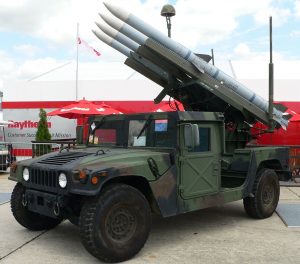By Ankit Panda
 The U.S. Department of State has approved a possible sale to India of military equipment comprising an integrated air defense weapon system (IADWS), the U.S. Defense Security Cooperation Agency announced in a statement Monday. The cost of the sale, if finalized, would be approximately $1.867 billion. The DSCA announcement comes shortly before an anticipated trip to India by U.S. President Donald J. Trump later this month. Trump is expected to visit India for a two-day trip between February 23 and 26, according to Indian reports.
The U.S. Department of State has approved a possible sale to India of military equipment comprising an integrated air defense weapon system (IADWS), the U.S. Defense Security Cooperation Agency announced in a statement Monday. The cost of the sale, if finalized, would be approximately $1.867 billion. The DSCA announcement comes shortly before an anticipated trip to India by U.S. President Donald J. Trump later this month. Trump is expected to visit India for a two-day trip between February 23 and 26, according to Indian reports.
The IADWS package that has been approved includes a range of sensors, weapons systems, and support equipment. Included in the potential sale are AN/MPQ-64Fl Sentinel radar systems, AMRAAM AIM-120C-7/C-8 missiles and associated guidance and control equipment, and Stinger FIM-92L missiles. The sale also includes M4A1 rifles, M855 5.56mm cartridges, and a range of other associated equipment.
“This proposed sale will support the foreign policy and national security of the United States by helping to strengthen the U.S.-Indian strategic relationship and to improve the security of a major defensive partner, which continues to be an important force for political stability, peace, and economic progress in the Indo-Pacific and South Asia region,” the DSCA release noted.
“India intends to use these defense articles and services to modernize its armed forces, and to expand its existing air defense architecture to counter threats posed by air attack,” the U.S. statement continued. “This will contribute to India’s military goal to update its capability while further enhancing greater interoperability between India, the U.S., and other allies. India will have no difficulty absorbing these systems into its armed forces.”
Defense ties between the United States and India have been growing in recent years. In June 2017, during their first meeting, Indian Prime Minister Narendra Modi said that the “strengthening of India’s defense capabilities, with the help of USA, is something that we truly appreciate.”
Over the last decade, the United States has emerged as a major defense supplier to India. India, meanwhile, is the world’s largest importer of defense equipment, accounting for some 12 percent of global defense imports, according to the Stockholm International Peace Research Institute’s 2018 yearbook.
India has been gradually modernizing and expanding its air defense networks, but a concern for New Delhi remains its inability to integrate several major systems. For instance, if the sale of this U.S.-approved IADWS package were to be approved, Indian forces would have to operate them in isolation from Russia-procured systems like the S-400 surface-to-air missile system, which India is slated to begin receiving later this year. The S-400 and the U.S. IADWS each cover different parts of the aerial threat environment, with the Russian system covering higher-altitude threats at longer ranges.
India has also been developing a range of indigenous air defense systems, including the Akash Mk1/Mk1S, both of which are in production (Akash Mk1 is operational). The Quick Reaction Surface-to-Air Missile (QRSAM), another indigenously developed low-altitude interceptor, is in trials. India also operates the Israeli surface-to-air Python and Debry (SPYDer) system, which covers short- and medium-range threats at low altitudes.
Separate from the IADWS sale, Reuters reported on Monday that India may give final approval to a $2.6 billion sale for military helicopters from Lockheed Martin, a major U.S. defense firm. The sale would include 24 MH-60R Seahawk helicopters for use by the Indian Navy.
No comments:
Post a Comment